MBA Project: Determinants of SME Credit Access in Ga East Municipality
VerifiedAdded on 2023/06/12
|40
|14424
|453
Project
AI Summary
This project investigates the factors influencing Small and Medium Enterprises (SMEs) access to credit in the Ga East Municipality of Ghana. It highlights the significance of SMEs to Ghana's economy and the challenges they face in securing funding. The study identifies sources of credit available to SMEs, assesses the factors that influence credit accessibility, including convenience, security, and interest rates, and investigates the impact of electronic banking. The research employs questionnaires to gather data and analyzes the determinants of credit access, aiming to provide insights for government, financial institutions, and SMEs to improve financial inclusion and support SME growth. The findings contribute to the existing literature on SME finance in Ghana and offer recommendations for future research and policy interventions.
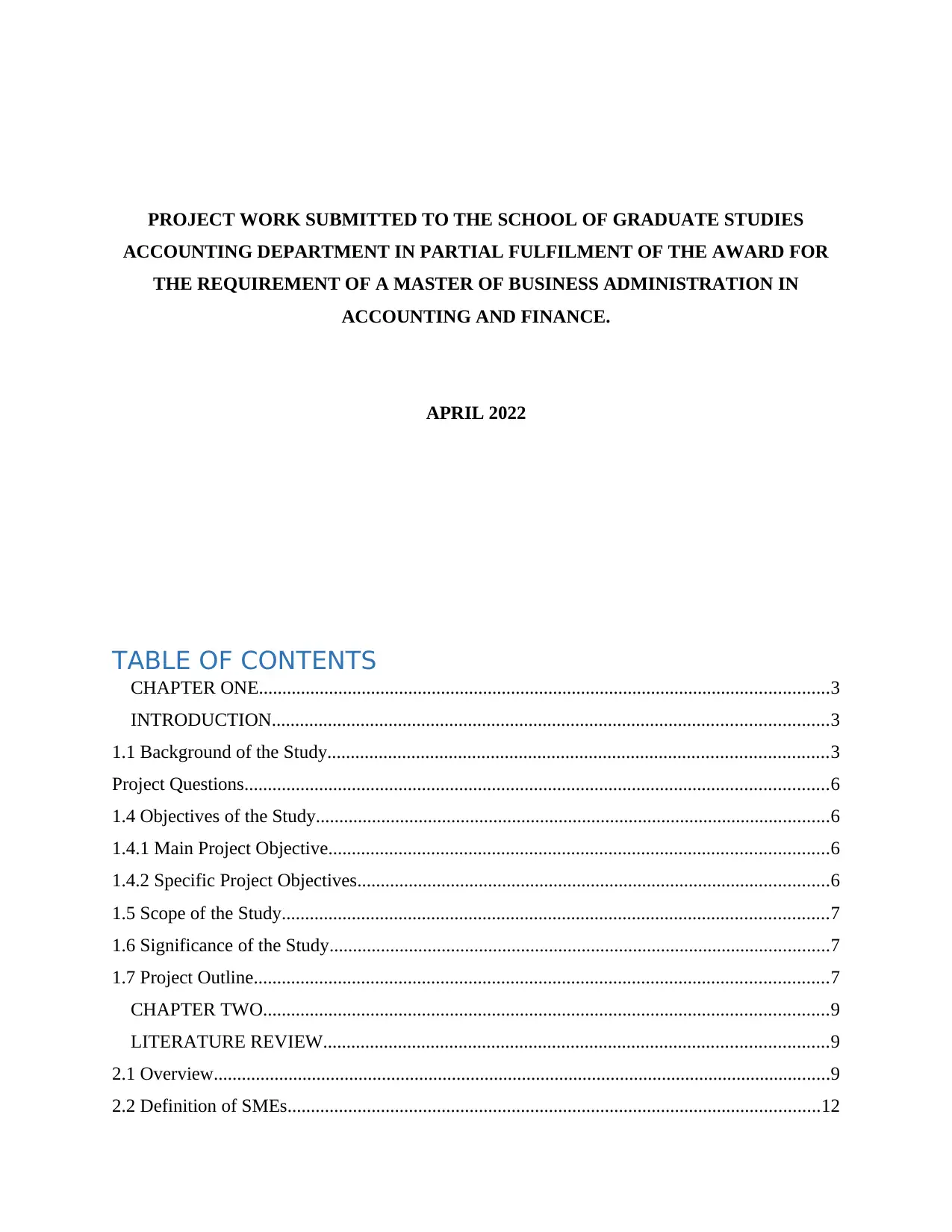
PROJECT WORK SUBMITTED TO THE SCHOOL OF GRADUATE STUDIES
ACCOUNTING DEPARTMENT IN PARTIAL FULFILMENT OF THE AWARD FOR
THE REQUIREMENT OF A MASTER OF BUSINESS ADMINISTRATION IN
ACCOUNTING AND FINANCE.
APRIL 2022
TABLE OF CONTENTS
CHAPTER ONE..........................................................................................................................3
INTRODUCTION.......................................................................................................................3
1.1 Background of the Study...........................................................................................................3
Project Questions.............................................................................................................................6
1.4 Objectives of the Study..............................................................................................................6
1.4.1 Main Project Objective...........................................................................................................6
1.4.2 Specific Project Objectives.....................................................................................................6
1.5 Scope of the Study.....................................................................................................................7
1.6 Significance of the Study...........................................................................................................7
1.7 Project Outline...........................................................................................................................7
CHAPTER TWO.........................................................................................................................9
LITERATURE REVIEW............................................................................................................9
2.1 Overview....................................................................................................................................9
2.2 Definition of SMEs..................................................................................................................12
ACCOUNTING DEPARTMENT IN PARTIAL FULFILMENT OF THE AWARD FOR
THE REQUIREMENT OF A MASTER OF BUSINESS ADMINISTRATION IN
ACCOUNTING AND FINANCE.
APRIL 2022
TABLE OF CONTENTS
CHAPTER ONE..........................................................................................................................3
INTRODUCTION.......................................................................................................................3
1.1 Background of the Study...........................................................................................................3
Project Questions.............................................................................................................................6
1.4 Objectives of the Study..............................................................................................................6
1.4.1 Main Project Objective...........................................................................................................6
1.4.2 Specific Project Objectives.....................................................................................................6
1.5 Scope of the Study.....................................................................................................................7
1.6 Significance of the Study...........................................................................................................7
1.7 Project Outline...........................................................................................................................7
CHAPTER TWO.........................................................................................................................9
LITERATURE REVIEW............................................................................................................9
2.1 Overview....................................................................................................................................9
2.2 Definition of SMEs..................................................................................................................12
Paraphrase This Document
Need a fresh take? Get an instant paraphrase of this document with our AI Paraphraser
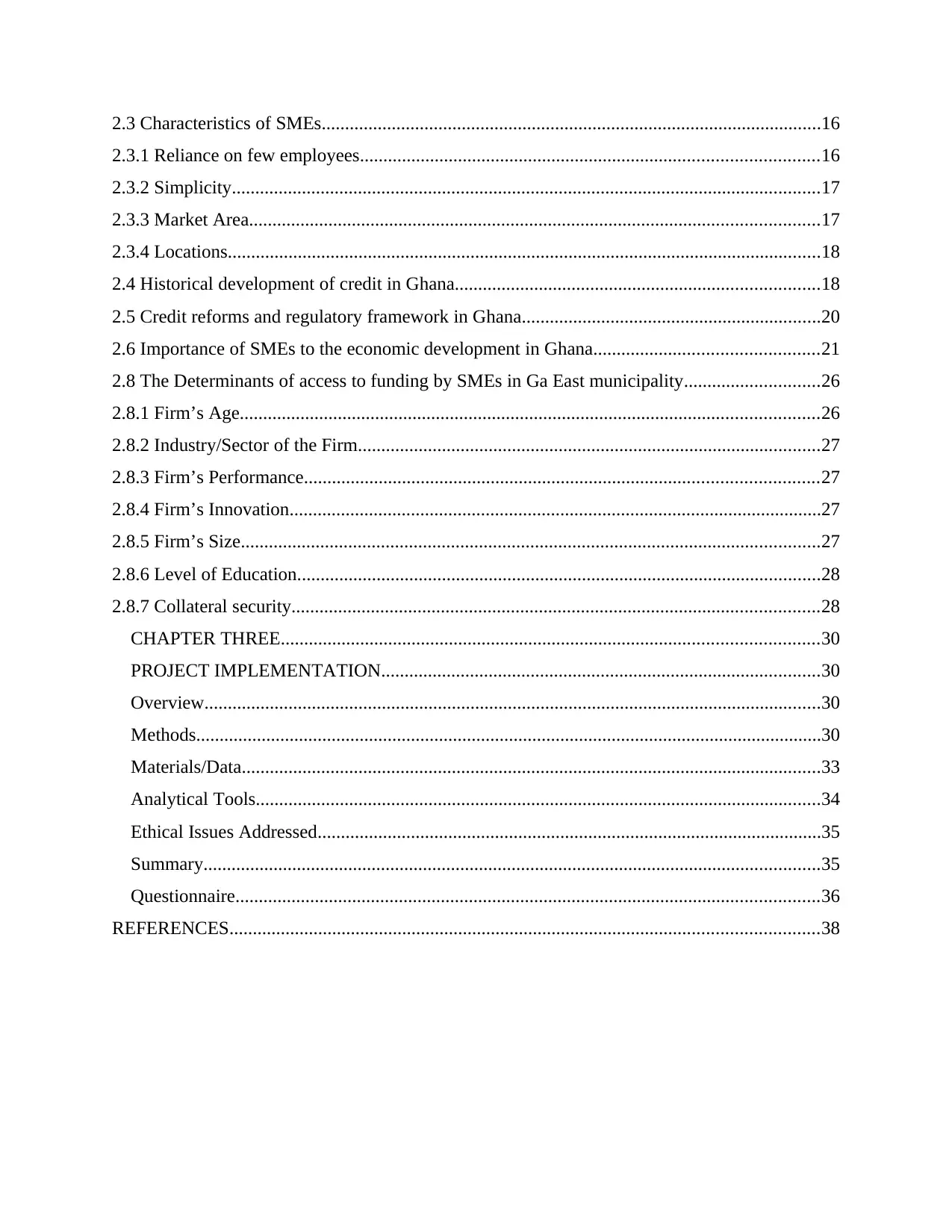
2.3 Characteristics of SMEs...........................................................................................................16
2.3.1 Reliance on few employees..................................................................................................16
2.3.2 Simplicity..............................................................................................................................17
2.3.3 Market Area..........................................................................................................................17
2.3.4 Locations...............................................................................................................................18
2.4 Historical development of credit in Ghana..............................................................................18
2.5 Credit reforms and regulatory framework in Ghana................................................................20
2.6 Importance of SMEs to the economic development in Ghana................................................21
2.8 The Determinants of access to funding by SMEs in Ga East municipality.............................26
2.8.1 Firm’s Age............................................................................................................................26
2.8.2 Industry/Sector of the Firm...................................................................................................27
2.8.3 Firm’s Performance..............................................................................................................27
2.8.4 Firm’s Innovation..................................................................................................................27
2.8.5 Firm’s Size............................................................................................................................27
2.8.6 Level of Education................................................................................................................28
2.8.7 Collateral security.................................................................................................................28
CHAPTER THREE...................................................................................................................30
PROJECT IMPLEMENTATION..............................................................................................30
Overview....................................................................................................................................30
Methods......................................................................................................................................30
Materials/Data............................................................................................................................33
Analytical Tools.........................................................................................................................34
Ethical Issues Addressed............................................................................................................35
Summary....................................................................................................................................35
Questionnaire.............................................................................................................................36
REFERENCES..............................................................................................................................38
2.3.1 Reliance on few employees..................................................................................................16
2.3.2 Simplicity..............................................................................................................................17
2.3.3 Market Area..........................................................................................................................17
2.3.4 Locations...............................................................................................................................18
2.4 Historical development of credit in Ghana..............................................................................18
2.5 Credit reforms and regulatory framework in Ghana................................................................20
2.6 Importance of SMEs to the economic development in Ghana................................................21
2.8 The Determinants of access to funding by SMEs in Ga East municipality.............................26
2.8.1 Firm’s Age............................................................................................................................26
2.8.2 Industry/Sector of the Firm...................................................................................................27
2.8.3 Firm’s Performance..............................................................................................................27
2.8.4 Firm’s Innovation..................................................................................................................27
2.8.5 Firm’s Size............................................................................................................................27
2.8.6 Level of Education................................................................................................................28
2.8.7 Collateral security.................................................................................................................28
CHAPTER THREE...................................................................................................................30
PROJECT IMPLEMENTATION..............................................................................................30
Overview....................................................................................................................................30
Methods......................................................................................................................................30
Materials/Data............................................................................................................................33
Analytical Tools.........................................................................................................................34
Ethical Issues Addressed............................................................................................................35
Summary....................................................................................................................................35
Questionnaire.............................................................................................................................36
REFERENCES..............................................................................................................................38
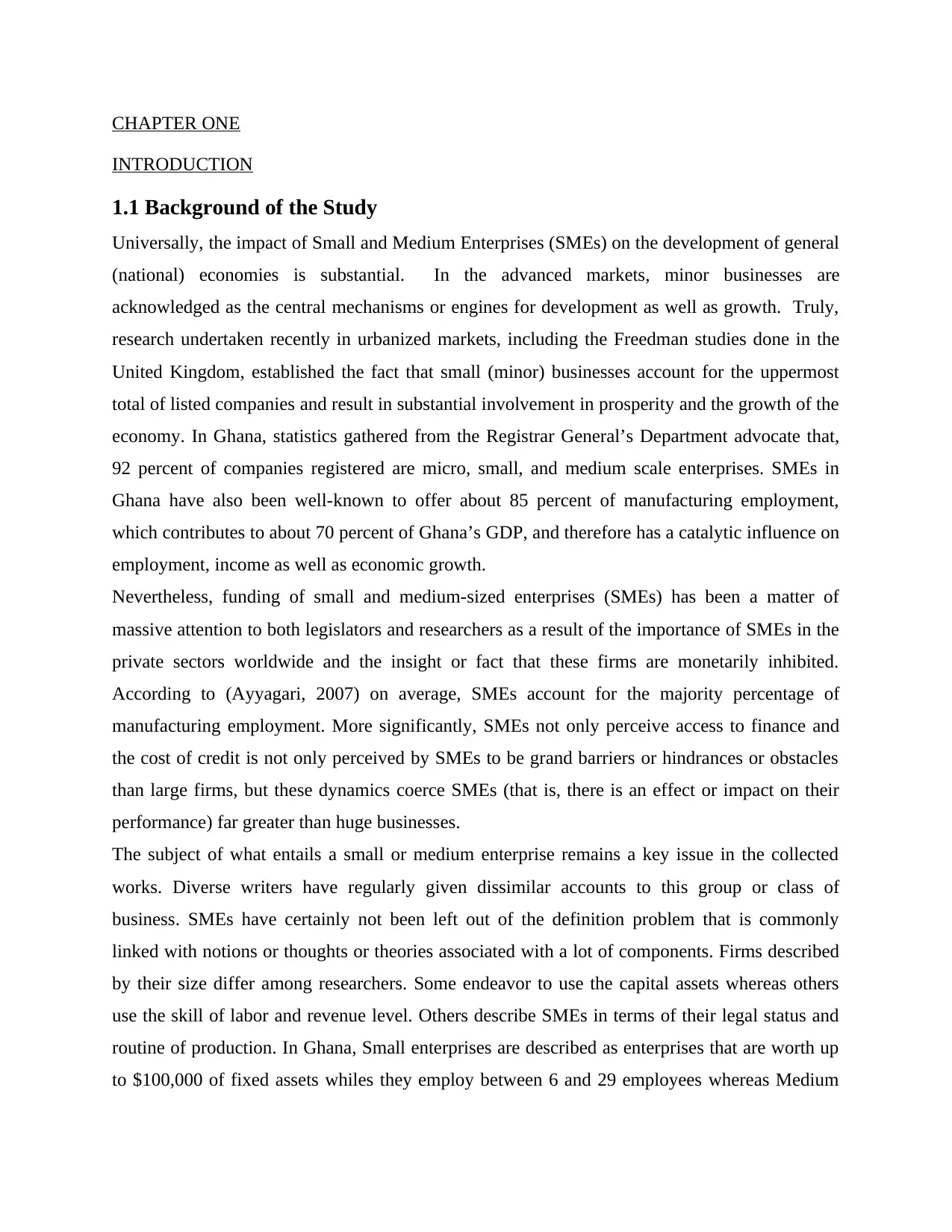
CHAPTER ONE
INTRODUCTION
1.1 Background of the Study
Universally, the impact of Small and Medium Enterprises (SMEs) on the development of general
(national) economies is substantial. In the advanced markets, minor businesses are
acknowledged as the central mechanisms or engines for development as well as growth. Truly,
research undertaken recently in urbanized markets, including the Freedman studies done in the
United Kingdom, established the fact that small (minor) businesses account for the uppermost
total of listed companies and result in substantial involvement in prosperity and the growth of the
economy. In Ghana, statistics gathered from the Registrar General’s Department advocate that,
92 percent of companies registered are micro, small, and medium scale enterprises. SMEs in
Ghana have also been well-known to offer about 85 percent of manufacturing employment,
which contributes to about 70 percent of Ghana’s GDP, and therefore has a catalytic influence on
employment, income as well as economic growth.
Nevertheless, funding of small and medium-sized enterprises (SMEs) has been a matter of
massive attention to both legislators and researchers as a result of the importance of SMEs in the
private sectors worldwide and the insight or fact that these firms are monetarily inhibited.
According to (Ayyagari, 2007) on average, SMEs account for the majority percentage of
manufacturing employment. More significantly, SMEs not only perceive access to finance and
the cost of credit is not only perceived by SMEs to be grand barriers or hindrances or obstacles
than large firms, but these dynamics coerce SMEs (that is, there is an effect or impact on their
performance) far greater than huge businesses.
The subject of what entails a small or medium enterprise remains a key issue in the collected
works. Diverse writers have regularly given dissimilar accounts to this group or class of
business. SMEs have certainly not been left out of the definition problem that is commonly
linked with notions or thoughts or theories associated with a lot of components. Firms described
by their size differ among researchers. Some endeavor to use the capital assets whereas others
use the skill of labor and revenue level. Others describe SMEs in terms of their legal status and
routine of production. In Ghana, Small enterprises are described as enterprises that are worth up
to $100,000 of fixed assets whiles they employ between 6 and 29 employees whereas Medium
INTRODUCTION
1.1 Background of the Study
Universally, the impact of Small and Medium Enterprises (SMEs) on the development of general
(national) economies is substantial. In the advanced markets, minor businesses are
acknowledged as the central mechanisms or engines for development as well as growth. Truly,
research undertaken recently in urbanized markets, including the Freedman studies done in the
United Kingdom, established the fact that small (minor) businesses account for the uppermost
total of listed companies and result in substantial involvement in prosperity and the growth of the
economy. In Ghana, statistics gathered from the Registrar General’s Department advocate that,
92 percent of companies registered are micro, small, and medium scale enterprises. SMEs in
Ghana have also been well-known to offer about 85 percent of manufacturing employment,
which contributes to about 70 percent of Ghana’s GDP, and therefore has a catalytic influence on
employment, income as well as economic growth.
Nevertheless, funding of small and medium-sized enterprises (SMEs) has been a matter of
massive attention to both legislators and researchers as a result of the importance of SMEs in the
private sectors worldwide and the insight or fact that these firms are monetarily inhibited.
According to (Ayyagari, 2007) on average, SMEs account for the majority percentage of
manufacturing employment. More significantly, SMEs not only perceive access to finance and
the cost of credit is not only perceived by SMEs to be grand barriers or hindrances or obstacles
than large firms, but these dynamics coerce SMEs (that is, there is an effect or impact on their
performance) far greater than huge businesses.
The subject of what entails a small or medium enterprise remains a key issue in the collected
works. Diverse writers have regularly given dissimilar accounts to this group or class of
business. SMEs have certainly not been left out of the definition problem that is commonly
linked with notions or thoughts or theories associated with a lot of components. Firms described
by their size differ among researchers. Some endeavor to use the capital assets whereas others
use the skill of labor and revenue level. Others describe SMEs in terms of their legal status and
routine of production. In Ghana, Small enterprises are described as enterprises that are worth up
to $100,000 of fixed assets whiles they employ between 6 and 29 employees whereas Medium
⊘ This is a preview!⊘
Do you want full access?
Subscribe today to unlock all pages.

Trusted by 1+ million students worldwide
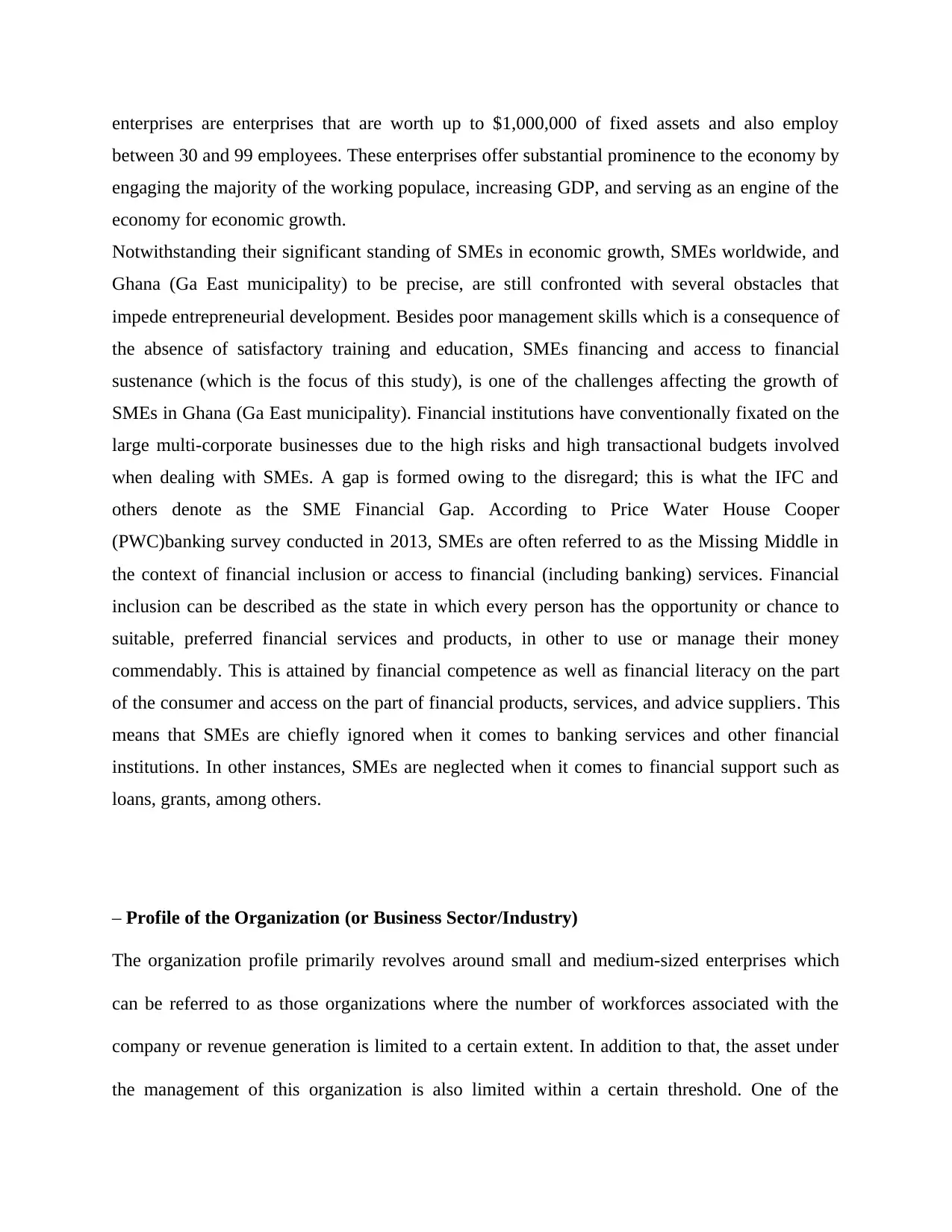
enterprises are enterprises that are worth up to $1,000,000 of fixed assets and also employ
between 30 and 99 employees. These enterprises offer substantial prominence to the economy by
engaging the majority of the working populace, increasing GDP, and serving as an engine of the
economy for economic growth.
Notwithstanding their significant standing of SMEs in economic growth, SMEs worldwide, and
Ghana (Ga East municipality) to be precise, are still confronted with several obstacles that
impede entrepreneurial development. Besides poor management skills which is a consequence of
the absence of satisfactory training and education, SMEs financing and access to financial
sustenance (which is the focus of this study), is one of the challenges affecting the growth of
SMEs in Ghana (Ga East municipality). Financial institutions have conventionally fixated on the
large multi-corporate businesses due to the high risks and high transactional budgets involved
when dealing with SMEs. A gap is formed owing to the disregard; this is what the IFC and
others denote as the SME Financial Gap. According to Price Water House Cooper
(PWC)banking survey conducted in 2013, SMEs are often referred to as the Missing Middle in
the context of financial inclusion or access to financial (including banking) services. Financial
inclusion can be described as the state in which every person has the opportunity or chance to
suitable, preferred financial services and products, in other to use or manage their money
commendably. This is attained by financial competence as well as financial literacy on the part
of the consumer and access on the part of financial products, services, and advice suppliers. This
means that SMEs are chiefly ignored when it comes to banking services and other financial
institutions. In other instances, SMEs are neglected when it comes to financial support such as
loans, grants, among others.
– Profile of the Organization (or Business Sector/Industry)
The organization profile primarily revolves around small and medium-sized enterprises which
can be referred to as those organizations where the number of workforces associated with the
company or revenue generation is limited to a certain extent. In addition to that, the asset under
the management of this organization is also limited within a certain threshold. One of the
between 30 and 99 employees. These enterprises offer substantial prominence to the economy by
engaging the majority of the working populace, increasing GDP, and serving as an engine of the
economy for economic growth.
Notwithstanding their significant standing of SMEs in economic growth, SMEs worldwide, and
Ghana (Ga East municipality) to be precise, are still confronted with several obstacles that
impede entrepreneurial development. Besides poor management skills which is a consequence of
the absence of satisfactory training and education, SMEs financing and access to financial
sustenance (which is the focus of this study), is one of the challenges affecting the growth of
SMEs in Ghana (Ga East municipality). Financial institutions have conventionally fixated on the
large multi-corporate businesses due to the high risks and high transactional budgets involved
when dealing with SMEs. A gap is formed owing to the disregard; this is what the IFC and
others denote as the SME Financial Gap. According to Price Water House Cooper
(PWC)banking survey conducted in 2013, SMEs are often referred to as the Missing Middle in
the context of financial inclusion or access to financial (including banking) services. Financial
inclusion can be described as the state in which every person has the opportunity or chance to
suitable, preferred financial services and products, in other to use or manage their money
commendably. This is attained by financial competence as well as financial literacy on the part
of the consumer and access on the part of financial products, services, and advice suppliers. This
means that SMEs are chiefly ignored when it comes to banking services and other financial
institutions. In other instances, SMEs are neglected when it comes to financial support such as
loans, grants, among others.
– Profile of the Organization (or Business Sector/Industry)
The organization profile primarily revolves around small and medium-sized enterprises which
can be referred to as those organizations where the number of workforces associated with the
company or revenue generation is limited to a certain extent. In addition to that, the asset under
the management of this organization is also limited within a certain threshold. One of the
Paraphrase This Document
Need a fresh take? Get an instant paraphrase of this document with our AI Paraphraser
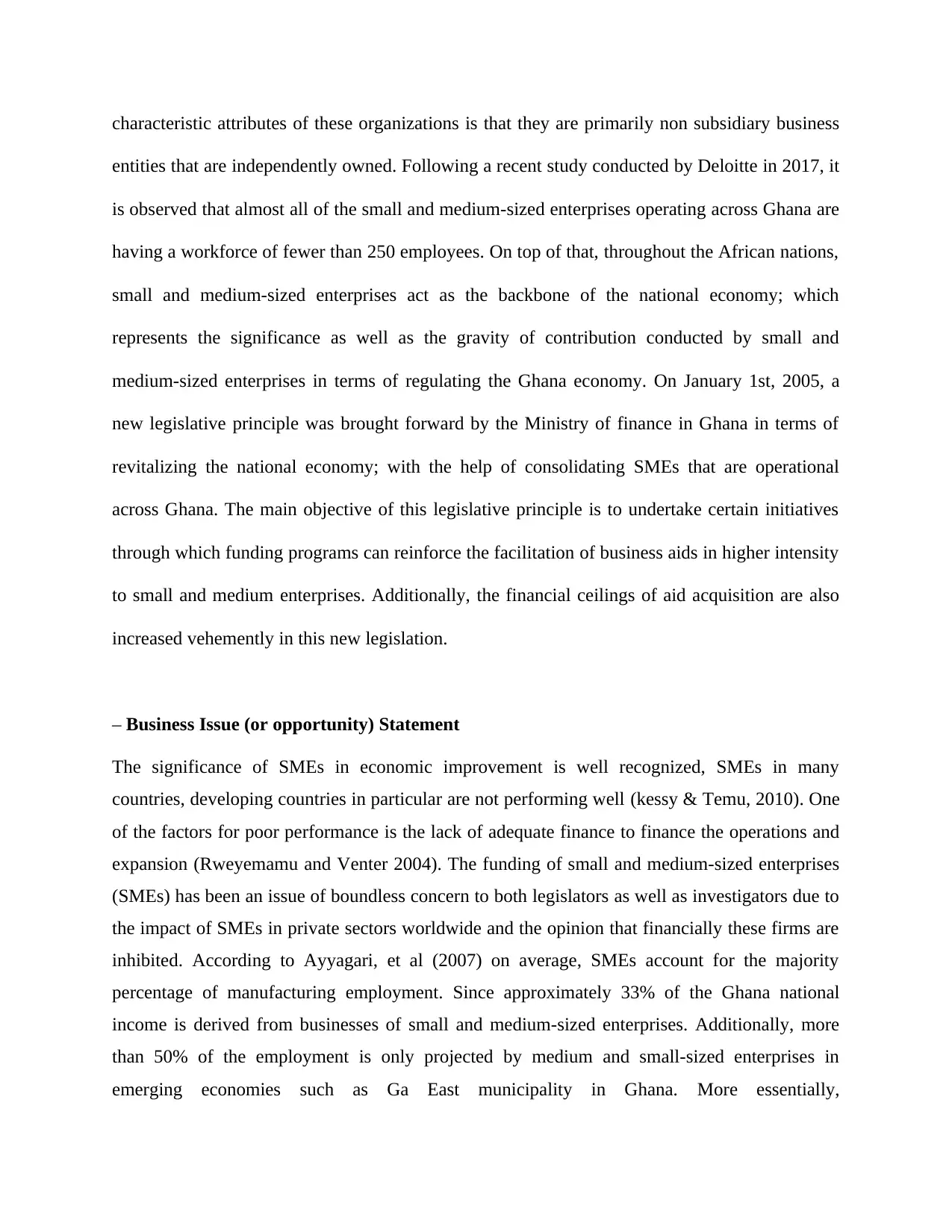
characteristic attributes of these organizations is that they are primarily non subsidiary business
entities that are independently owned. Following a recent study conducted by Deloitte in 2017, it
is observed that almost all of the small and medium-sized enterprises operating across Ghana are
having a workforce of fewer than 250 employees. On top of that, throughout the African nations,
small and medium-sized enterprises act as the backbone of the national economy; which
represents the significance as well as the gravity of contribution conducted by small and
medium-sized enterprises in terms of regulating the Ghana economy. On January 1st, 2005, a
new legislative principle was brought forward by the Ministry of finance in Ghana in terms of
revitalizing the national economy; with the help of consolidating SMEs that are operational
across Ghana. The main objective of this legislative principle is to undertake certain initiatives
through which funding programs can reinforce the facilitation of business aids in higher intensity
to small and medium enterprises. Additionally, the financial ceilings of aid acquisition are also
increased vehemently in this new legislation.
– Business Issue (or opportunity) Statement
The significance of SMEs in economic improvement is well recognized, SMEs in many
countries, developing countries in particular are not performing well (kessy & Temu, 2010). One
of the factors for poor performance is the lack of adequate finance to finance the operations and
expansion (Rweyemamu and Venter 2004). The funding of small and medium-sized enterprises
(SMEs) has been an issue of boundless concern to both legislators as well as investigators due to
the impact of SMEs in private sectors worldwide and the opinion that financially these firms are
inhibited. According to Ayyagari, et al (2007) on average, SMEs account for the majority
percentage of manufacturing employment. Since approximately 33% of the Ghana national
income is derived from businesses of small and medium-sized enterprises. Additionally, more
than 50% of the employment is only projected by medium and small-sized enterprises in
emerging economies such as Ga East municipality in Ghana. More essentially,
entities that are independently owned. Following a recent study conducted by Deloitte in 2017, it
is observed that almost all of the small and medium-sized enterprises operating across Ghana are
having a workforce of fewer than 250 employees. On top of that, throughout the African nations,
small and medium-sized enterprises act as the backbone of the national economy; which
represents the significance as well as the gravity of contribution conducted by small and
medium-sized enterprises in terms of regulating the Ghana economy. On January 1st, 2005, a
new legislative principle was brought forward by the Ministry of finance in Ghana in terms of
revitalizing the national economy; with the help of consolidating SMEs that are operational
across Ghana. The main objective of this legislative principle is to undertake certain initiatives
through which funding programs can reinforce the facilitation of business aids in higher intensity
to small and medium enterprises. Additionally, the financial ceilings of aid acquisition are also
increased vehemently in this new legislation.
– Business Issue (or opportunity) Statement
The significance of SMEs in economic improvement is well recognized, SMEs in many
countries, developing countries in particular are not performing well (kessy & Temu, 2010). One
of the factors for poor performance is the lack of adequate finance to finance the operations and
expansion (Rweyemamu and Venter 2004). The funding of small and medium-sized enterprises
(SMEs) has been an issue of boundless concern to both legislators as well as investigators due to
the impact of SMEs in private sectors worldwide and the opinion that financially these firms are
inhibited. According to Ayyagari, et al (2007) on average, SMEs account for the majority
percentage of manufacturing employment. Since approximately 33% of the Ghana national
income is derived from businesses of small and medium-sized enterprises. Additionally, more
than 50% of the employment is only projected by medium and small-sized enterprises in
emerging economies such as Ga East municipality in Ghana. More essentially,
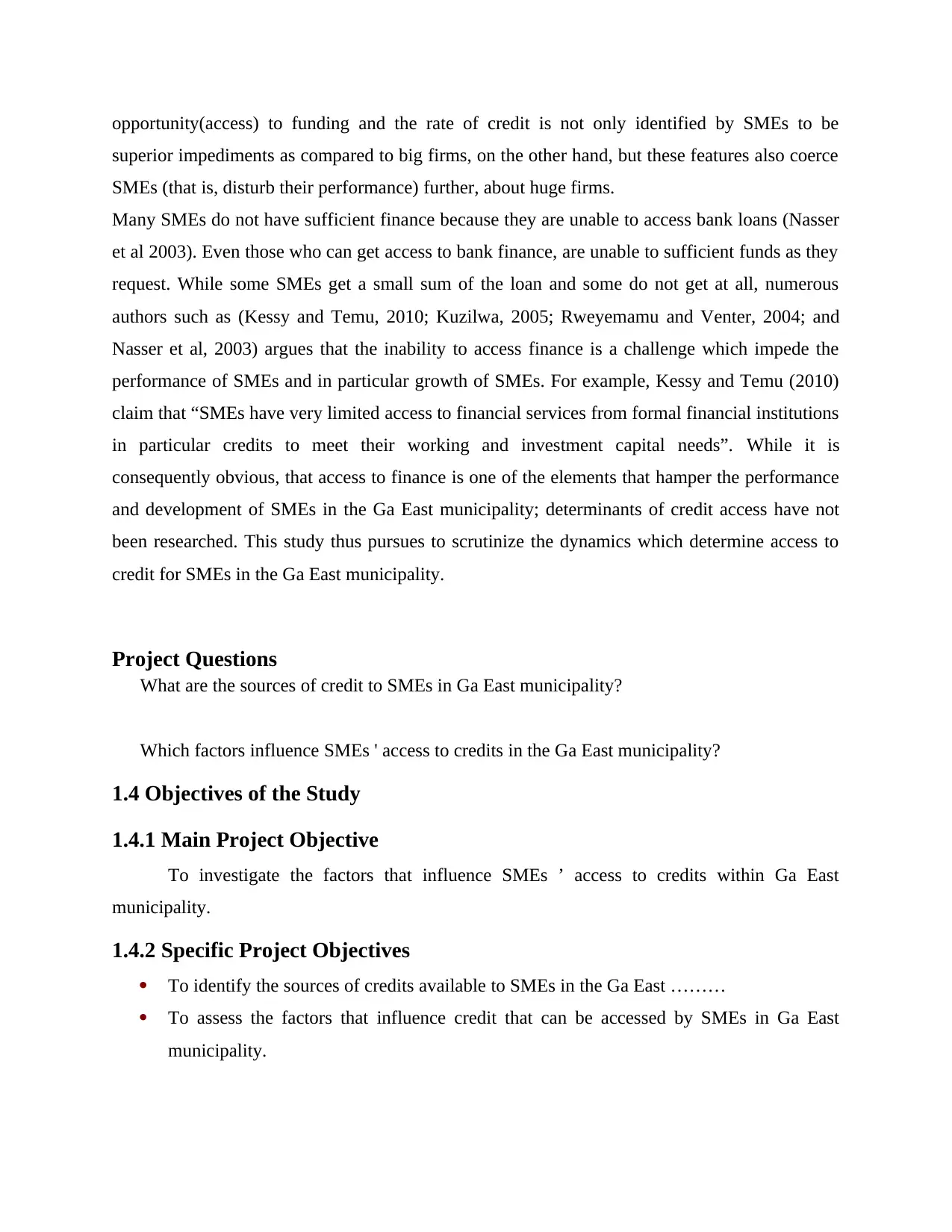
opportunity(access) to funding and the rate of credit is not only identified by SMEs to be
superior impediments as compared to big firms, on the other hand, but these features also coerce
SMEs (that is, disturb their performance) further, about huge firms.
Many SMEs do not have sufficient finance because they are unable to access bank loans (Nasser
et al 2003). Even those who can get access to bank finance, are unable to sufficient funds as they
request. While some SMEs get a small sum of the loan and some do not get at all, numerous
authors such as (Kessy and Temu, 2010; Kuzilwa, 2005; Rweyemamu and Venter, 2004; and
Nasser et al, 2003) argues that the inability to access finance is a challenge which impede the
performance of SMEs and in particular growth of SMEs. For example, Kessy and Temu (2010)
claim that “SMEs have very limited access to financial services from formal financial institutions
in particular credits to meet their working and investment capital needs”. While it is
consequently obvious, that access to finance is one of the elements that hamper the performance
and development of SMEs in the Ga East municipality; determinants of credit access have not
been researched. This study thus pursues to scrutinize the dynamics which determine access to
credit for SMEs in the Ga East municipality.
Project Questions
What are the sources of credit to SMEs in Ga East municipality?
Which factors influence SMEs ' access to credits in the Ga East municipality?
1.4 Objectives of the Study
1.4.1 Main Project Objective
To investigate the factors that influence SMEs ’ access to credits within Ga East
municipality.
1.4.2 Specific Project Objectives
To identify the sources of credits available to SMEs in the Ga East ………
To assess the factors that influence credit that can be accessed by SMEs in Ga East
municipality.
superior impediments as compared to big firms, on the other hand, but these features also coerce
SMEs (that is, disturb their performance) further, about huge firms.
Many SMEs do not have sufficient finance because they are unable to access bank loans (Nasser
et al 2003). Even those who can get access to bank finance, are unable to sufficient funds as they
request. While some SMEs get a small sum of the loan and some do not get at all, numerous
authors such as (Kessy and Temu, 2010; Kuzilwa, 2005; Rweyemamu and Venter, 2004; and
Nasser et al, 2003) argues that the inability to access finance is a challenge which impede the
performance of SMEs and in particular growth of SMEs. For example, Kessy and Temu (2010)
claim that “SMEs have very limited access to financial services from formal financial institutions
in particular credits to meet their working and investment capital needs”. While it is
consequently obvious, that access to finance is one of the elements that hamper the performance
and development of SMEs in the Ga East municipality; determinants of credit access have not
been researched. This study thus pursues to scrutinize the dynamics which determine access to
credit for SMEs in the Ga East municipality.
Project Questions
What are the sources of credit to SMEs in Ga East municipality?
Which factors influence SMEs ' access to credits in the Ga East municipality?
1.4 Objectives of the Study
1.4.1 Main Project Objective
To investigate the factors that influence SMEs ’ access to credits within Ga East
municipality.
1.4.2 Specific Project Objectives
To identify the sources of credits available to SMEs in the Ga East ………
To assess the factors that influence credit that can be accessed by SMEs in Ga East
municipality.
⊘ This is a preview!⊘
Do you want full access?
Subscribe today to unlock all pages.

Trusted by 1+ million students worldwide
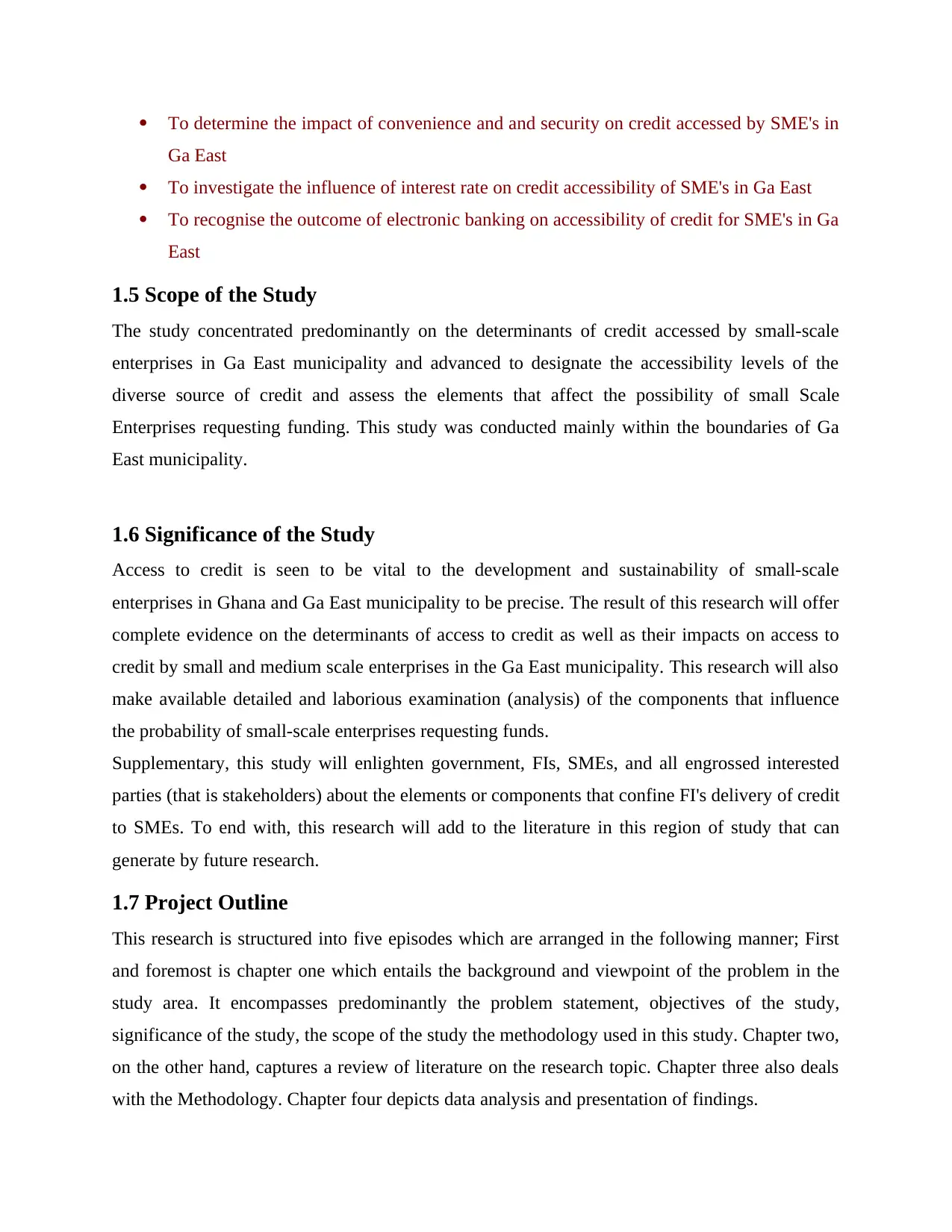
To determine the impact of convenience and and security on credit accessed by SME's in
Ga East
To investigate the influence of interest rate on credit accessibility of SME's in Ga East
To recognise the outcome of electronic banking on accessibility of credit for SME's in Ga
East
1.5 Scope of the Study
The study concentrated predominantly on the determinants of credit accessed by small-scale
enterprises in Ga East municipality and advanced to designate the accessibility levels of the
diverse source of credit and assess the elements that affect the possibility of small Scale
Enterprises requesting funding. This study was conducted mainly within the boundaries of Ga
East municipality.
1.6 Significance of the Study
Access to credit is seen to be vital to the development and sustainability of small-scale
enterprises in Ghana and Ga East municipality to be precise. The result of this research will offer
complete evidence on the determinants of access to credit as well as their impacts on access to
credit by small and medium scale enterprises in the Ga East municipality. This research will also
make available detailed and laborious examination (analysis) of the components that influence
the probability of small-scale enterprises requesting funds.
Supplementary, this study will enlighten government, FIs, SMEs, and all engrossed interested
parties (that is stakeholders) about the elements or components that confine FI's delivery of credit
to SMEs. To end with, this research will add to the literature in this region of study that can
generate by future research.
1.7 Project Outline
This research is structured into five episodes which are arranged in the following manner; First
and foremost is chapter one which entails the background and viewpoint of the problem in the
study area. It encompasses predominantly the problem statement, objectives of the study,
significance of the study, the scope of the study the methodology used in this study. Chapter two,
on the other hand, captures a review of literature on the research topic. Chapter three also deals
with the Methodology. Chapter four depicts data analysis and presentation of findings.
Ga East
To investigate the influence of interest rate on credit accessibility of SME's in Ga East
To recognise the outcome of electronic banking on accessibility of credit for SME's in Ga
East
1.5 Scope of the Study
The study concentrated predominantly on the determinants of credit accessed by small-scale
enterprises in Ga East municipality and advanced to designate the accessibility levels of the
diverse source of credit and assess the elements that affect the possibility of small Scale
Enterprises requesting funding. This study was conducted mainly within the boundaries of Ga
East municipality.
1.6 Significance of the Study
Access to credit is seen to be vital to the development and sustainability of small-scale
enterprises in Ghana and Ga East municipality to be precise. The result of this research will offer
complete evidence on the determinants of access to credit as well as their impacts on access to
credit by small and medium scale enterprises in the Ga East municipality. This research will also
make available detailed and laborious examination (analysis) of the components that influence
the probability of small-scale enterprises requesting funds.
Supplementary, this study will enlighten government, FIs, SMEs, and all engrossed interested
parties (that is stakeholders) about the elements or components that confine FI's delivery of credit
to SMEs. To end with, this research will add to the literature in this region of study that can
generate by future research.
1.7 Project Outline
This research is structured into five episodes which are arranged in the following manner; First
and foremost is chapter one which entails the background and viewpoint of the problem in the
study area. It encompasses predominantly the problem statement, objectives of the study,
significance of the study, the scope of the study the methodology used in this study. Chapter two,
on the other hand, captures a review of literature on the research topic. Chapter three also deals
with the Methodology. Chapter four depicts data analysis and presentation of findings.
Paraphrase This Document
Need a fresh take? Get an instant paraphrase of this document with our AI Paraphraser
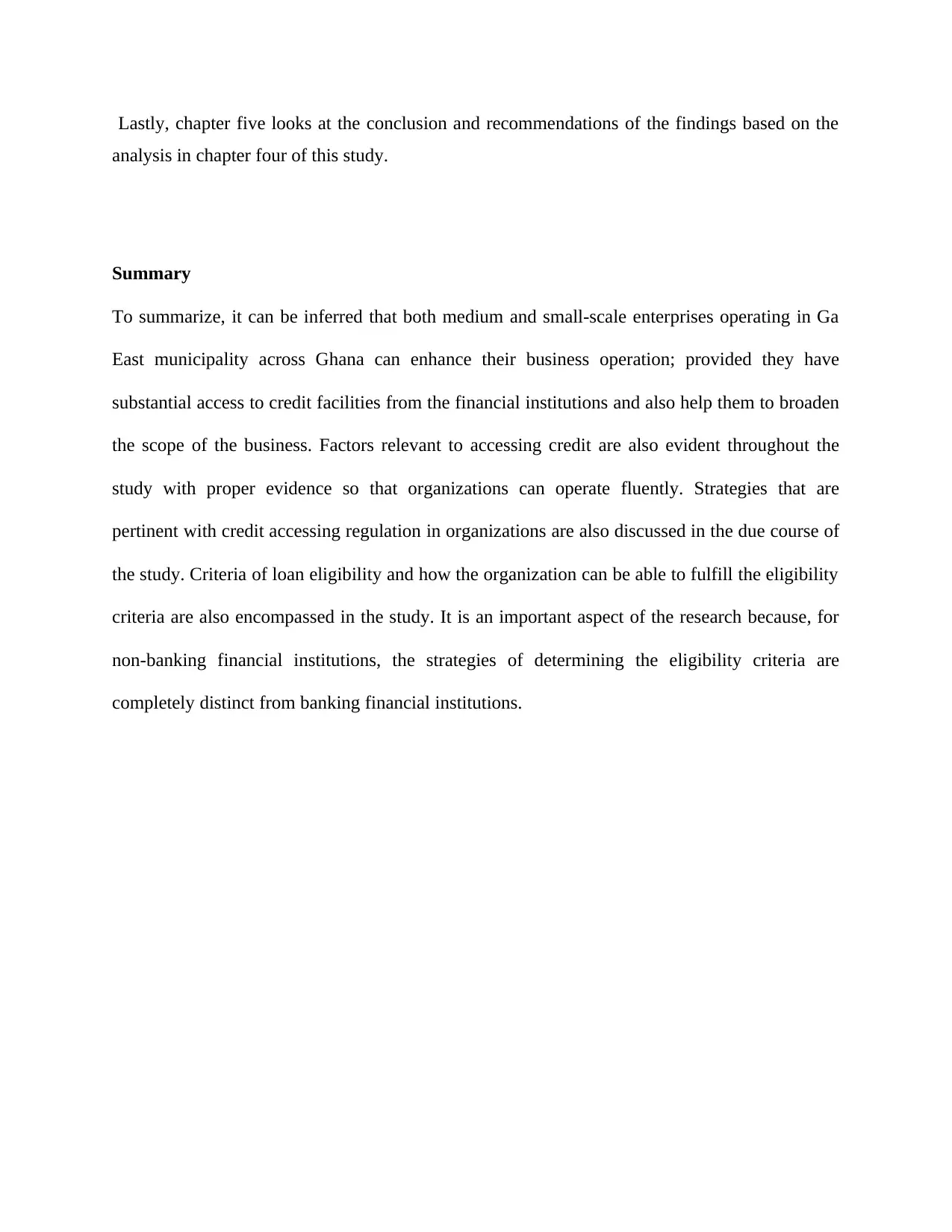
Lastly, chapter five looks at the conclusion and recommendations of the findings based on the
analysis in chapter four of this study.
Summary
To summarize, it can be inferred that both medium and small-scale enterprises operating in Ga
East municipality across Ghana can enhance their business operation; provided they have
substantial access to credit facilities from the financial institutions and also help them to broaden
the scope of the business. Factors relevant to accessing credit are also evident throughout the
study with proper evidence so that organizations can operate fluently. Strategies that are
pertinent with credit accessing regulation in organizations are also discussed in the due course of
the study. Criteria of loan eligibility and how the organization can be able to fulfill the eligibility
criteria are also encompassed in the study. It is an important aspect of the research because, for
non-banking financial institutions, the strategies of determining the eligibility criteria are
completely distinct from banking financial institutions.
analysis in chapter four of this study.
Summary
To summarize, it can be inferred that both medium and small-scale enterprises operating in Ga
East municipality across Ghana can enhance their business operation; provided they have
substantial access to credit facilities from the financial institutions and also help them to broaden
the scope of the business. Factors relevant to accessing credit are also evident throughout the
study with proper evidence so that organizations can operate fluently. Strategies that are
pertinent with credit accessing regulation in organizations are also discussed in the due course of
the study. Criteria of loan eligibility and how the organization can be able to fulfill the eligibility
criteria are also encompassed in the study. It is an important aspect of the research because, for
non-banking financial institutions, the strategies of determining the eligibility criteria are
completely distinct from banking financial institutions.
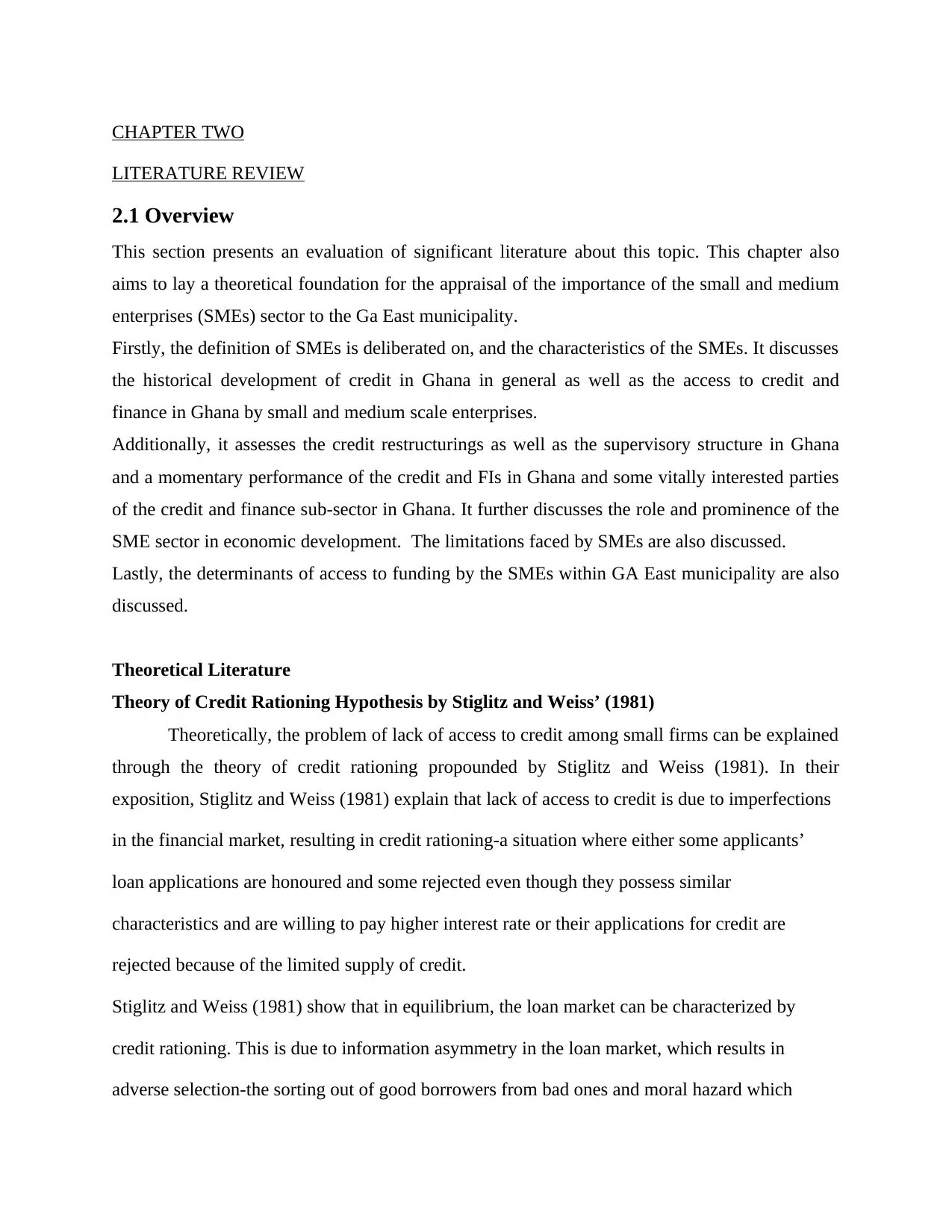
CHAPTER TWO
LITERATURE REVIEW
2.1 Overview
This section presents an evaluation of significant literature about this topic. This chapter also
aims to lay a theoretical foundation for the appraisal of the importance of the small and medium
enterprises (SMEs) sector to the Ga East municipality.
Firstly, the definition of SMEs is deliberated on, and the characteristics of the SMEs. It discusses
the historical development of credit in Ghana in general as well as the access to credit and
finance in Ghana by small and medium scale enterprises.
Additionally, it assesses the credit restructurings as well as the supervisory structure in Ghana
and a momentary performance of the credit and FIs in Ghana and some vitally interested parties
of the credit and finance sub-sector in Ghana. It further discusses the role and prominence of the
SME sector in economic development. The limitations faced by SMEs are also discussed.
Lastly, the determinants of access to funding by the SMEs within GA East municipality are also
discussed.
Theoretical Literature
Theory of Credit Rationing Hypothesis by Stiglitz and Weiss’ (1981)
Theoretically, the problem of lack of access to credit among small firms can be explained
through the theory of credit rationing propounded by Stiglitz and Weiss (1981). In their
exposition, Stiglitz and Weiss (1981) explain that lack of access to credit is due to imperfections
in the financial market, resulting in credit rationing-a situation where either some applicants’
loan applications are honoured and some rejected even though they possess similar
characteristics and are willing to pay higher interest rate or their applications for credit are
rejected because of the limited supply of credit.
Stiglitz and Weiss (1981) show that in equilibrium, the loan market can be characterized by
credit rationing. This is due to information asymmetry in the loan market, which results in
adverse selection-the sorting out of good borrowers from bad ones and moral hazard which
LITERATURE REVIEW
2.1 Overview
This section presents an evaluation of significant literature about this topic. This chapter also
aims to lay a theoretical foundation for the appraisal of the importance of the small and medium
enterprises (SMEs) sector to the Ga East municipality.
Firstly, the definition of SMEs is deliberated on, and the characteristics of the SMEs. It discusses
the historical development of credit in Ghana in general as well as the access to credit and
finance in Ghana by small and medium scale enterprises.
Additionally, it assesses the credit restructurings as well as the supervisory structure in Ghana
and a momentary performance of the credit and FIs in Ghana and some vitally interested parties
of the credit and finance sub-sector in Ghana. It further discusses the role and prominence of the
SME sector in economic development. The limitations faced by SMEs are also discussed.
Lastly, the determinants of access to funding by the SMEs within GA East municipality are also
discussed.
Theoretical Literature
Theory of Credit Rationing Hypothesis by Stiglitz and Weiss’ (1981)
Theoretically, the problem of lack of access to credit among small firms can be explained
through the theory of credit rationing propounded by Stiglitz and Weiss (1981). In their
exposition, Stiglitz and Weiss (1981) explain that lack of access to credit is due to imperfections
in the financial market, resulting in credit rationing-a situation where either some applicants’
loan applications are honoured and some rejected even though they possess similar
characteristics and are willing to pay higher interest rate or their applications for credit are
rejected because of the limited supply of credit.
Stiglitz and Weiss (1981) show that in equilibrium, the loan market can be characterized by
credit rationing. This is due to information asymmetry in the loan market, which results in
adverse selection-the sorting out of good borrowers from bad ones and moral hazard which
⊘ This is a preview!⊘
Do you want full access?
Subscribe today to unlock all pages.

Trusted by 1+ million students worldwide
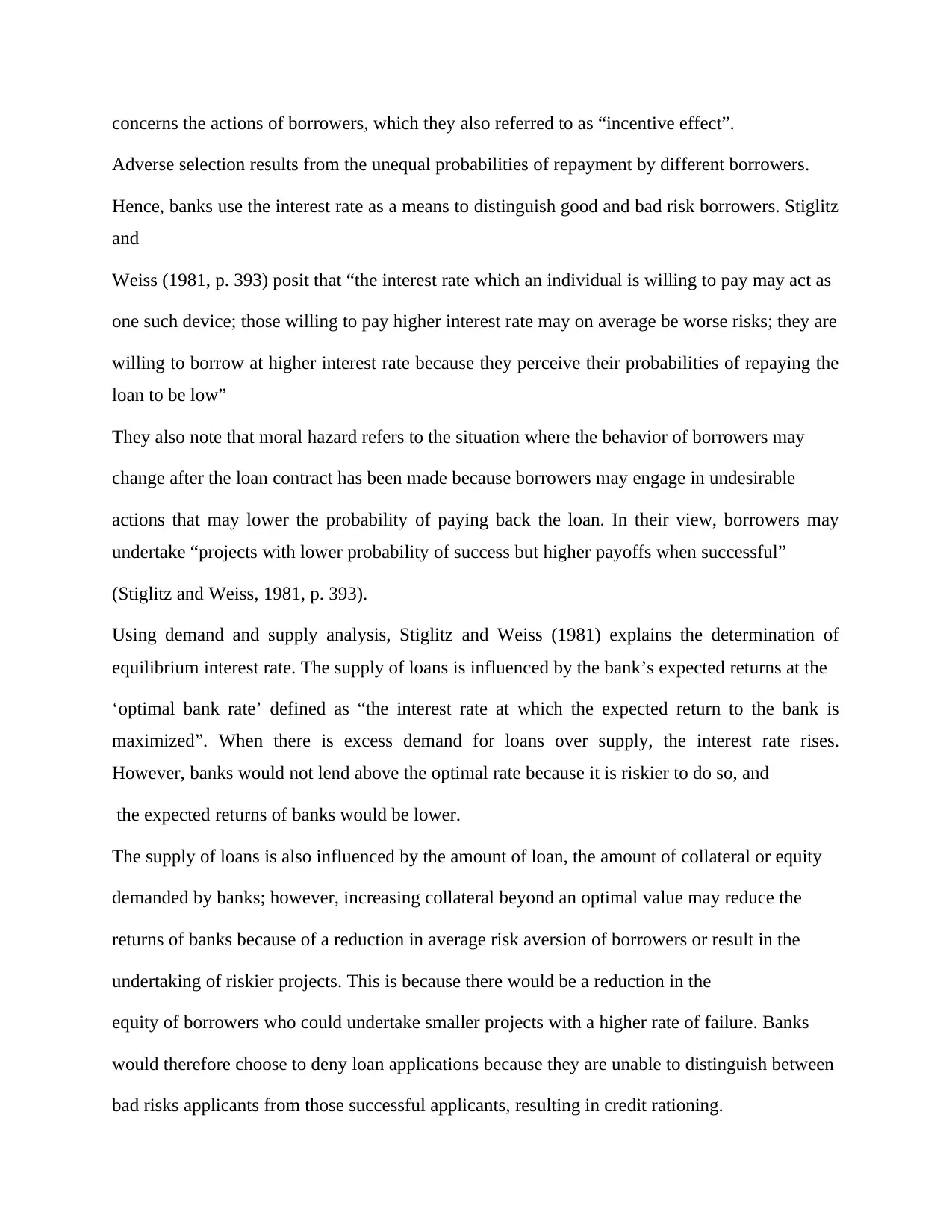
concerns the actions of borrowers, which they also referred to as “incentive effect”.
Adverse selection results from the unequal probabilities of repayment by different borrowers.
Hence, banks use the interest rate as a means to distinguish good and bad risk borrowers. Stiglitz
and
Weiss (1981, p. 393) posit that “the interest rate which an individual is willing to pay may act as
one such device; those willing to pay higher interest rate may on average be worse risks; they are
willing to borrow at higher interest rate because they perceive their probabilities of repaying the
loan to be low”
They also note that moral hazard refers to the situation where the behavior of borrowers may
change after the loan contract has been made because borrowers may engage in undesirable
actions that may lower the probability of paying back the loan. In their view, borrowers may
undertake “projects with lower probability of success but higher payoffs when successful”
(Stiglitz and Weiss, 1981, p. 393).
Using demand and supply analysis, Stiglitz and Weiss (1981) explains the determination of
equilibrium interest rate. The supply of loans is influenced by the bank’s expected returns at the
‘optimal bank rate’ defined as “the interest rate at which the expected return to the bank is
maximized”. When there is excess demand for loans over supply, the interest rate rises.
However, banks would not lend above the optimal rate because it is riskier to do so, and
the expected returns of banks would be lower.
The supply of loans is also influenced by the amount of loan, the amount of collateral or equity
demanded by banks; however, increasing collateral beyond an optimal value may reduce the
returns of banks because of a reduction in average risk aversion of borrowers or result in the
undertaking of riskier projects. This is because there would be a reduction in the
equity of borrowers who could undertake smaller projects with a higher rate of failure. Banks
would therefore choose to deny loan applications because they are unable to distinguish between
bad risks applicants from those successful applicants, resulting in credit rationing.
Adverse selection results from the unequal probabilities of repayment by different borrowers.
Hence, banks use the interest rate as a means to distinguish good and bad risk borrowers. Stiglitz
and
Weiss (1981, p. 393) posit that “the interest rate which an individual is willing to pay may act as
one such device; those willing to pay higher interest rate may on average be worse risks; they are
willing to borrow at higher interest rate because they perceive their probabilities of repaying the
loan to be low”
They also note that moral hazard refers to the situation where the behavior of borrowers may
change after the loan contract has been made because borrowers may engage in undesirable
actions that may lower the probability of paying back the loan. In their view, borrowers may
undertake “projects with lower probability of success but higher payoffs when successful”
(Stiglitz and Weiss, 1981, p. 393).
Using demand and supply analysis, Stiglitz and Weiss (1981) explains the determination of
equilibrium interest rate. The supply of loans is influenced by the bank’s expected returns at the
‘optimal bank rate’ defined as “the interest rate at which the expected return to the bank is
maximized”. When there is excess demand for loans over supply, the interest rate rises.
However, banks would not lend above the optimal rate because it is riskier to do so, and
the expected returns of banks would be lower.
The supply of loans is also influenced by the amount of loan, the amount of collateral or equity
demanded by banks; however, increasing collateral beyond an optimal value may reduce the
returns of banks because of a reduction in average risk aversion of borrowers or result in the
undertaking of riskier projects. This is because there would be a reduction in the
equity of borrowers who could undertake smaller projects with a higher rate of failure. Banks
would therefore choose to deny loan applications because they are unable to distinguish between
bad risks applicants from those successful applicants, resulting in credit rationing.
Paraphrase This Document
Need a fresh take? Get an instant paraphrase of this document with our AI Paraphraser
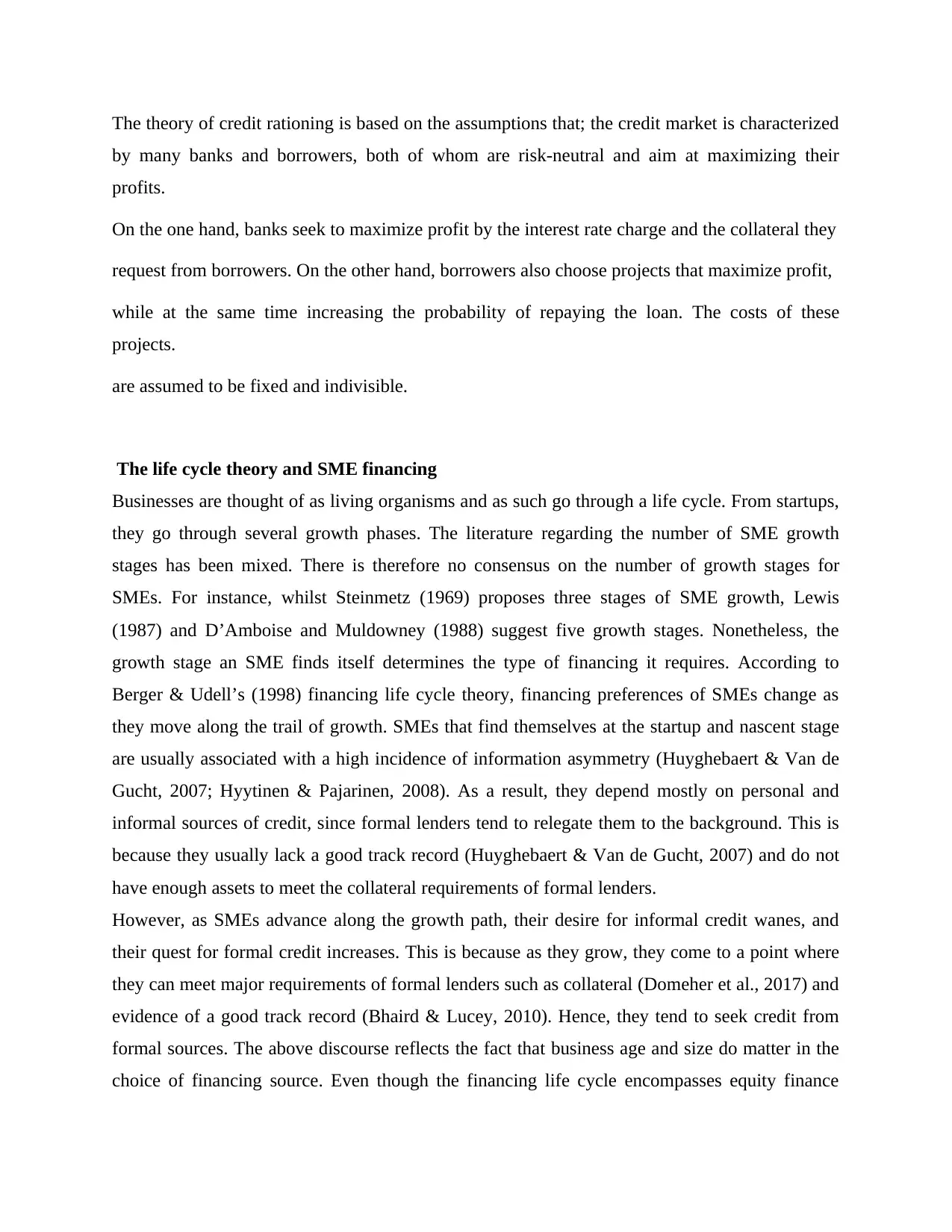
The theory of credit rationing is based on the assumptions that; the credit market is characterized
by many banks and borrowers, both of whom are risk-neutral and aim at maximizing their
profits.
On the one hand, banks seek to maximize profit by the interest rate charge and the collateral they
request from borrowers. On the other hand, borrowers also choose projects that maximize profit,
while at the same time increasing the probability of repaying the loan. The costs of these
projects.
are assumed to be fixed and indivisible.
The life cycle theory and SME financing
Businesses are thought of as living organisms and as such go through a life cycle. From startups,
they go through several growth phases. The literature regarding the number of SME growth
stages has been mixed. There is therefore no consensus on the number of growth stages for
SMEs. For instance, whilst Steinmetz (1969) proposes three stages of SME growth, Lewis
(1987) and D’Amboise and Muldowney (1988) suggest five growth stages. Nonetheless, the
growth stage an SME finds itself determines the type of financing it requires. According to
Berger & Udell’s (1998) financing life cycle theory, financing preferences of SMEs change as
they move along the trail of growth. SMEs that find themselves at the startup and nascent stage
are usually associated with a high incidence of information asymmetry (Huyghebaert & Van de
Gucht, 2007; Hyytinen & Pajarinen, 2008). As a result, they depend mostly on personal and
informal sources of credit, since formal lenders tend to relegate them to the background. This is
because they usually lack a good track record (Huyghebaert & Van de Gucht, 2007) and do not
have enough assets to meet the collateral requirements of formal lenders.
However, as SMEs advance along the growth path, their desire for informal credit wanes, and
their quest for formal credit increases. This is because as they grow, they come to a point where
they can meet major requirements of formal lenders such as collateral (Domeher et al., 2017) and
evidence of a good track record (Bhaird & Lucey, 2010). Hence, they tend to seek credit from
formal sources. The above discourse reflects the fact that business age and size do matter in the
choice of financing source. Even though the financing life cycle encompasses equity finance
by many banks and borrowers, both of whom are risk-neutral and aim at maximizing their
profits.
On the one hand, banks seek to maximize profit by the interest rate charge and the collateral they
request from borrowers. On the other hand, borrowers also choose projects that maximize profit,
while at the same time increasing the probability of repaying the loan. The costs of these
projects.
are assumed to be fixed and indivisible.
The life cycle theory and SME financing
Businesses are thought of as living organisms and as such go through a life cycle. From startups,
they go through several growth phases. The literature regarding the number of SME growth
stages has been mixed. There is therefore no consensus on the number of growth stages for
SMEs. For instance, whilst Steinmetz (1969) proposes three stages of SME growth, Lewis
(1987) and D’Amboise and Muldowney (1988) suggest five growth stages. Nonetheless, the
growth stage an SME finds itself determines the type of financing it requires. According to
Berger & Udell’s (1998) financing life cycle theory, financing preferences of SMEs change as
they move along the trail of growth. SMEs that find themselves at the startup and nascent stage
are usually associated with a high incidence of information asymmetry (Huyghebaert & Van de
Gucht, 2007; Hyytinen & Pajarinen, 2008). As a result, they depend mostly on personal and
informal sources of credit, since formal lenders tend to relegate them to the background. This is
because they usually lack a good track record (Huyghebaert & Van de Gucht, 2007) and do not
have enough assets to meet the collateral requirements of formal lenders.
However, as SMEs advance along the growth path, their desire for informal credit wanes, and
their quest for formal credit increases. This is because as they grow, they come to a point where
they can meet major requirements of formal lenders such as collateral (Domeher et al., 2017) and
evidence of a good track record (Bhaird & Lucey, 2010). Hence, they tend to seek credit from
formal sources. The above discourse reflects the fact that business age and size do matter in the
choice of financing source. Even though the financing life cycle encompasses equity finance
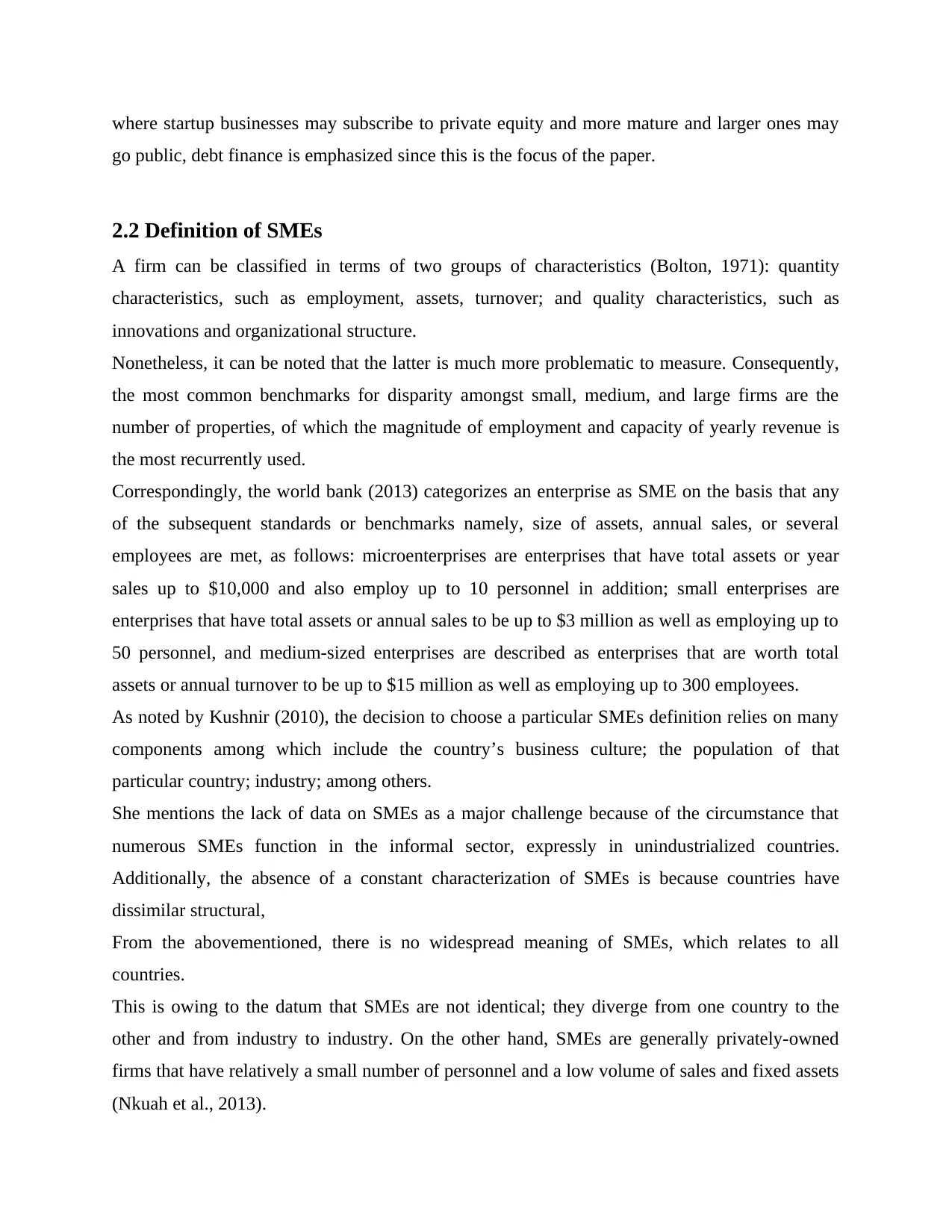
where startup businesses may subscribe to private equity and more mature and larger ones may
go public, debt finance is emphasized since this is the focus of the paper.
2.2 Definition of SMEs
A firm can be classified in terms of two groups of characteristics (Bolton, 1971): quantity
characteristics, such as employment, assets, turnover; and quality characteristics, such as
innovations and organizational structure.
Nonetheless, it can be noted that the latter is much more problematic to measure. Consequently,
the most common benchmarks for disparity amongst small, medium, and large firms are the
number of properties, of which the magnitude of employment and capacity of yearly revenue is
the most recurrently used.
Correspondingly, the world bank (2013) categorizes an enterprise as SME on the basis that any
of the subsequent standards or benchmarks namely, size of assets, annual sales, or several
employees are met, as follows: microenterprises are enterprises that have total assets or year
sales up to $10,000 and also employ up to 10 personnel in addition; small enterprises are
enterprises that have total assets or annual sales to be up to $3 million as well as employing up to
50 personnel, and medium-sized enterprises are described as enterprises that are worth total
assets or annual turnover to be up to $15 million as well as employing up to 300 employees.
As noted by Kushnir (2010), the decision to choose a particular SMEs definition relies on many
components among which include the country’s business culture; the population of that
particular country; industry; among others.
She mentions the lack of data on SMEs as a major challenge because of the circumstance that
numerous SMEs function in the informal sector, expressly in unindustrialized countries.
Additionally, the absence of a constant characterization of SMEs is because countries have
dissimilar structural,
From the abovementioned, there is no widespread meaning of SMEs, which relates to all
countries.
This is owing to the datum that SMEs are not identical; they diverge from one country to the
other and from industry to industry. On the other hand, SMEs are generally privately-owned
firms that have relatively a small number of personnel and a low volume of sales and fixed assets
(Nkuah et al., 2013).
go public, debt finance is emphasized since this is the focus of the paper.
2.2 Definition of SMEs
A firm can be classified in terms of two groups of characteristics (Bolton, 1971): quantity
characteristics, such as employment, assets, turnover; and quality characteristics, such as
innovations and organizational structure.
Nonetheless, it can be noted that the latter is much more problematic to measure. Consequently,
the most common benchmarks for disparity amongst small, medium, and large firms are the
number of properties, of which the magnitude of employment and capacity of yearly revenue is
the most recurrently used.
Correspondingly, the world bank (2013) categorizes an enterprise as SME on the basis that any
of the subsequent standards or benchmarks namely, size of assets, annual sales, or several
employees are met, as follows: microenterprises are enterprises that have total assets or year
sales up to $10,000 and also employ up to 10 personnel in addition; small enterprises are
enterprises that have total assets or annual sales to be up to $3 million as well as employing up to
50 personnel, and medium-sized enterprises are described as enterprises that are worth total
assets or annual turnover to be up to $15 million as well as employing up to 300 employees.
As noted by Kushnir (2010), the decision to choose a particular SMEs definition relies on many
components among which include the country’s business culture; the population of that
particular country; industry; among others.
She mentions the lack of data on SMEs as a major challenge because of the circumstance that
numerous SMEs function in the informal sector, expressly in unindustrialized countries.
Additionally, the absence of a constant characterization of SMEs is because countries have
dissimilar structural,
From the abovementioned, there is no widespread meaning of SMEs, which relates to all
countries.
This is owing to the datum that SMEs are not identical; they diverge from one country to the
other and from industry to industry. On the other hand, SMEs are generally privately-owned
firms that have relatively a small number of personnel and a low volume of sales and fixed assets
(Nkuah et al., 2013).
⊘ This is a preview!⊘
Do you want full access?
Subscribe today to unlock all pages.

Trusted by 1+ million students worldwide
1 out of 40
Related Documents
Your All-in-One AI-Powered Toolkit for Academic Success.
+13062052269
info@desklib.com
Available 24*7 on WhatsApp / Email
![[object Object]](/_next/static/media/star-bottom.7253800d.svg)
Unlock your academic potential
Copyright © 2020–2025 A2Z Services. All Rights Reserved. Developed and managed by ZUCOL.





